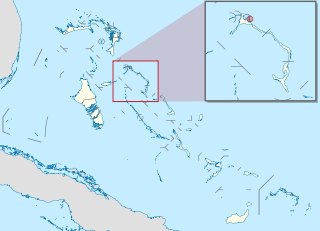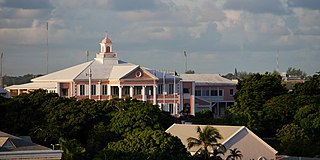Related Research Articles

The earliest arrival of people in the islands now known as The Bahamas was in the first millennium AD. The first inhabitants of the islands were the Lucayans, an Arawakan language-speaking Taino people, who arrived between about 500 and 800 AD from other islands of the Caribbean.

"March On, Bahamaland" is the national anthem of the Bahamas. Timothy Gibson composed the music and authored the lyrics. It was adopted as the national anthem in 1973, when the country gained independence from the United Kingdom.

Grand Bahama is the northernmost of the islands of the Bahamas, with the town of West End located 56 nautical miles east of Palm Beach, Florida. It is the third largest island in the Bahamas island chain of approximately 700 islands and 2,400 cays. The island is roughly 530 square miles (1,400 km2) in area and approximately 153 kilometres (95 mi) long west to east and 24 kilometres (15 mi) at its widest point north to south. Administratively, the island consists of the Freeport Bonded Area and the districts of East Grand Bahama and West Grand Bahama. Nearly half of the homes on the island were damaged or destroyed in early September 2019 by Hurricane Dorian.

The Out Islands are the islands that make up the Bahamas with the exception of New Providence Island, where the capital and largest city, Nassau, is located, and Grand Bahama Island, where Freeport is located. The Abaco Islands and Eleuthera islands are among the Out Islands.

Harbour Island is an island and administrative district in the Bahamas located off the northeast coast of Eleuthera Island. Harbour Island, Jacobs Island, Man Island (Bahamas), Pierre Island and others form what looks like a reef that encloses the east and north sides of a lagoon in the northeast corner of Eleuthera.

Government House is the official residence of the governor-general of the Bahamas, located in Nassau. It was built in the colonial days and was the residence of the governor of the Bahamas. It later continued in the role of official residence and office of the governor-general following political independence from the United Kingdom in 1973.
The Bahamas is a net importer of food, importing almost 90% of its food supply. Of food imports, 80% are from the United States.
Greek Bahamians comprise Bahamian citizens of either full or partial Greek heritage. Most residents, if not the entire Greek community, are the descendants of Greek labourers who came to the Bahamas in 1880s to develop the sponging industry.

Andrew Deveaux was an American Loyalist from South Carolina who is most famous for his recapture of the Bahamas in 1783.

The Capture of the Bahamas took place in April 1783, late in the American Revolutionary War, when a Loyalist expedition under the command of Andrew Deveaux set out to retake the Bahamas from the Spanish. The expedition was successful and Nassau fell without a shot being fired. It was one of the last actions of the entire war.

The Raid on Nassau, on the Bahamian island of New Providence, was a privately raised Franco-Spanish expedition against the English taking place in October 1703, during the War of the Spanish Succession; it was a Franco-Spanish victory, leading to Nassau's brief occupation, then its destruction. The joint Bourbon invasion was led by Blas Moreno Mondragón and Clause Le Chesnaye, with the attack focusing on Nassau, the capital of the English Bahamas, an important base of privateering for English corsairs in the Cuban and Saint Domingue's Caribbean seas. The town of Nassau was quickly taken and sacked, plundered and burnt down. The fort of Nassau was dismantled, and the English governor, with all the English soldiers were carried off prisoners. A year later, Sir Edward Birch, the new English governor, upon landing in Nassau, was so distraught at the ruin he found, that he returned to England after only a few months, without "unfurling his company-issued commission".
The Raid on Charles Town, or Spanish raid on New Providence, was a Spanish naval expedition on 19 January 1684 (O.S.) led by Cuban corsair Juan de Alarcón against the English privateering stronghold of Charles Town, capital of the Bahamas.
Sir Harry Edward Spiller Cordeaux KCMG CB was an Indian Army officer and colonial administrator who became in turn governor of Uganda, Saint Helena and the Bahamas.
John Tinker (1700–1758) was an early Colonial official who served the Royal African Company on the Gold Coast, was an Agent for the South Sea Company in Portobello, and was Royal Governor of the Bahama Islands from 1741–1758.
Quarino was an African-born inhabitant of New Providence, Bahamas who was part of a slave revolt.
Daniel Stillwell was a minor pirate in the Caribbean, best known for his association with Benjamin Hornigold.
Diane Gail North-Saunders, OBE was a Bahamian historian, archivist, athlete, and author.
Meta Davis Cumberbatch MBE was a Trinidad-born pianist, composer, poet, playwright and cultural activist, who spent the majority of her life in The Bahamas, where she used her talents to enhance the country's cultural development, becoming known as the "Mother of the Arts". At the 2014 Independence anniversary celebrations in Nassau she was honoured as a Bahamian "Cultural Warrior".
Louis Diston Powles (1842–1911) was an English barrister. He is now remembered for his outspoken memoir Land of the Pink Pearl of his time in the Bahamas as a stipendiary magistrate, during the 1880s.
Blayney Townley Balfour was Lieutenant Governor of the Bahamas from 1833 to 1835.
References
- ↑ "Islanders in the Stream: A History of the Bahamian People: Volume One: From Aboriginal Times to the End of Slavery (9780820321226): Craton, Michael, Saunders, Gail: Books". Amazon.com. Retrieved 2020-04-08.
- ↑ "The Migration of Peoples from the Caribbean to the Bahamas: Tinker, Keith L.: 9780813062129: Amazon.com: Books". Amazon.com. Retrieved 2020-04-08.
- ↑ Edwards, Charles Lincoln (April 8, 1895). "Bahama songs and stories. A contribution to folk-lore". Boston.